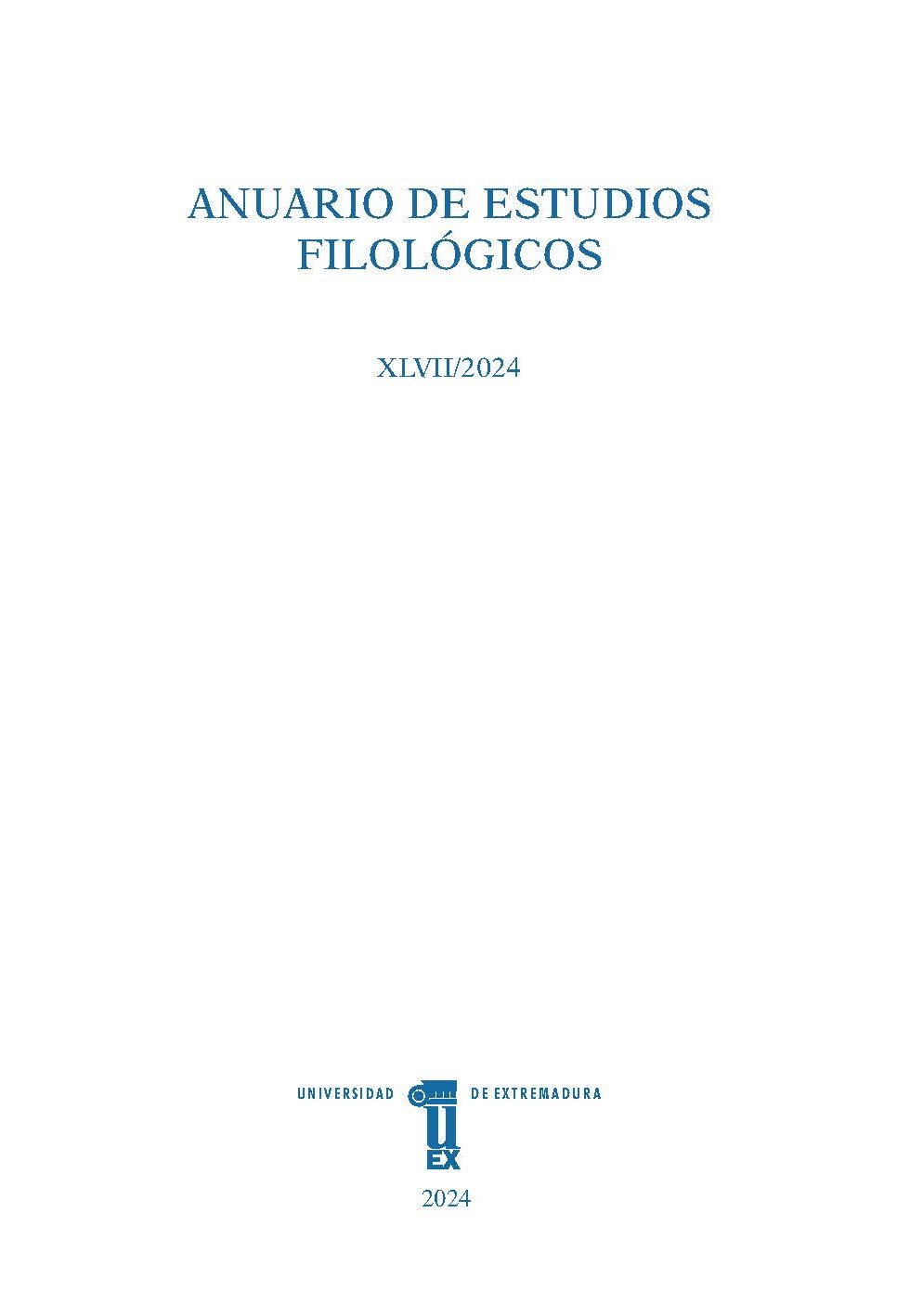The lexical expression of CIRCUMSTANCE and DEGREE in old English
DOI:
https://doi.org/10.17398/2660-7301.47.327Keywords:
affixation, lexical (macro)functions, Old English, circumstance, degreeAbstract
This paper explores the distribution of the affixal material and lexical meaning within the semantic categories ‘circumstance’ and ‘degree’. The analysis is confined to the predicates belonging to the four major lexical categories, namely verbs, nouns, adjectives, and adverbs, that have been formed either prefixally or suffixally. Special attention has been paid to affixal polysemy, which applies when a given form can be bound to more than one semantic rule. In this regard, it must be noted that both categories present a significant degree of affixal overlapping that is confirmed in the polysemous character of a group of affixes, which include for-, fore-, forð-, mid-, ofer-, on-, sin-, ūp- and ūt-. The analysis has also revealed that ‘circumstance’ is mainly characterized by affixes conveying location, whereas ‘degree’ is mainly defined in terms of affixes expressing intensity. On the whole, the study casts lights on the degree of compatibility among affixes and functions and on the patterns of recategorization that arise as a result of affixal processes.
Downloads
References
BOSWORTH, Joseph & TOLLER, Thomas Northcote (1973): An Anglo-Saxon Dictionary. Oxford: OUP [1898].
CAMERON, Angus et al. (2018): The Dictionary of Old English: A to I online. Toronto: University of Toronto (https://tapor.library.utoronto.ca/doe/).
CLARK HALL, John R. & MERRITT, Herbert T. (1896): A Concise Anglo-Saxon Dictionary. Toronto: University of Toronto.
DE LA CRUZ CABANILLAS, Isabel (2007): «Semantic primes in Old English: a preliminary study of descriptors». SELIM, 14, 37-58 (https://doi.org/10.17811/selim.14.2007.37-58).
DIK, Simon C. (1997): The Theory of Functional Grammar. Berlin-New York: De Gruyter Mouton (Part 1: The Structure of the Clause, https://doi.org/10.1515/9783110218367; Part 2: Complex and Derived Constructions, https://doi.org/10.1515/9783110218374).
FOLEY, William A. & VAN VALIN, Jr., Robert D. (1984): Functional Syntax and Universal Grammar. Cambridge: CUP.
GODDARD, Cliff (2002): «The Search for the Shared Semantic Core of All Languages». In Goddard, Cliff & Wierzbicka, Anna (eds.): Meaning and Universal Grammar. Theory and Empirical Findings. Amsterdam: John Benjamins, vol. I, 5-40 (https://doi.org/10.1075/slcs.60.07god).
GODDARD, Cliff (2012): «Semantic Primes, Semantic Molecules, Semantic Templates: Key Concepts in the NSM Approach to Lexical Typology». Linguistics, 50.3, 711-743 (https://doi.org/10.1515/LING-2012-0022).
GODDARD, Cliff & PEETERS, Bert (2006): «The Natural Semantic Metalanguage (NSM) Approach: An Overview with Reference to the Most Important Romance languages». In Peeters, Bert (ed.): Semantic Primes and Universal Grammar: Empirical Evidence from the Romance Languages. Amsterdam: John Benjamins, 13-38.
GODDARD, Cliff & WIERZBICKA, Anna (2002): «Semantic Primes and Universal Grammar». In Goddard, Cliff & Wierzbicka, Anna (eds.): Meaning and Universal Grammar. Theory and Empirical Findings. Amsterdam: John Benjamins, vol. I, 41-85 (https://doi.org/10.1075/slcs.81).
GUARDDON ANELO, M.ª Carmen (2009a): «The Natural Semantic Metalanguage of Old English Compound Adpositions». ES-English Studies, 30, 61-83.
GUARDDON ANELO, M.ª Carmen (2009b): «Un análisis de las propiedades combinatorias de los primitivos semánticos a través de las adposiciones complejas en inglés antiguo». Revista Española de Lingüística, 39.2, 93-122.
HASELOW, Alexander (2011): Typological Changes in the Lexicon. Analytic Tendencies in English Noun Formation. Berlin: Mouton de Gruyter.
HENGEVELD, Kees & MACKENZIE, J. Lachlan (2008): Functional Discourse Grammar. A typologically-based theory of language structure. Oxford: OUP.
JEMBER, Gregory K. et al. (1975): English-Old English, Old English-English Dictionary. Boulder (CO): Westview.
KASTOVSKY, Dieter (1992): «Semantics and vocabulary». In Hogg, Richard M. (ed.): The Cambridge History of the English Language I: The Beginnings to 1066. Cambridge: CUP, 290-408 (https://doi.org/10.1017/CHOL9780521264747.006).
KASTOVSKY, Dieter (2006): «Typological Changes in Derivational Morphology». In van Kemenade, Ans et al. (eds.): The Handbook of the History of English. Oxford: Blackwell, 151-177 (https://doi.org/10.1002/9780470757048.ch7).
LYONS, John (1995): Linguistic Semantics. Cambridge: CUP.
MARTÍN ARISTA, Javier (2008): «Unification and separation in a functional theory of morphology». In Van Valin, Robert D. (ed.): Investigations of the Syntax-Semantics-Pragmatics Interface. Amsterdam: John Benjamins, 119-145 (https://doi.org/10.1075/slcs.105.12mar).
MARTÍN ARISTA, Javier (2009): «A Typology of Morphological Constructions». In Butler, Christopher et al. (eds.): Deconstructing Constructions. Amsterdam: John Benjamins, 85-115 (https://doi.org/10.1075/slcs.107.06aty).
MARTÍN ARISTA, Javier (2010): «Lexical negation in Old English: Recategorization and Recursivity». NOWELE-North-Western European Language Evolution, 60/61, 89-108 (https://doi.org/10.1075/nowele.60-61.05ari).
MARTÍN ARISTA, Javier (2011): «Projections and constructions in functional morphology: the case of HRĒOW». Language and Linguistics, 12.2, 393-425.
MARTÍN ARISTA, Javier (2012): «Morfología flexiva en RRG». In Mairal, R. et al. (eds.): El funcionalismo en la teoría lingüística. Madrid: Akal, 43-58.
MARTÍN ARISTA, Javier et al. (eds.) (2016): NerthusV3. Online Lexical Database of Old English. Nerthus Project. Universidad de La Rioja (www.nerthusproject.com).
MARTÍN ARISTA, Javier & MARTÍN DE LA ROSA, Victoria (2006): «Old English Semantic Primes: Substantives, Determiners and Quantifiers». Atlantis, 17, 9-28.
MATEO MENDAZA, Raquel (2013): «The Old English exponent for the semantic prime TOUCH. Descriptive and methodological questions». Australian Journal of Linguistics, 33.4, 449-466 (https://doi.org/10.1080/07268602.2013.857574).
MATEO MENDAZA, Raquel (2016a): «The search for Old English semantic primes: the case of HAPPEN». Nordic Journal of English Studies, 15.1, 71-99 (https://doi.org/10.35360/njes.352).
MATEO MENDAZA, Raquel (2016b): «The Old English exponent for the semantic prime MOVE». Australian Journal of Linguistics, 36.4, 542-559 (https://doi.org/10.1080/07268602.2016.1169976).
MATEO MENDAZA, Raquel (2020): «Semantic Primes in Historical Languages. The identification of the Old English Exponent for DO». Journal of English Studies, 18, 125-152 (https://doi.org/10.18172/jes.4467).
MATEO MENDAZA, Raquel (2021): «Identifying the Old English exponent for the semantic prime LIVE». SELIM, 26, 85-107 (https://doi.org/10.17811/selim.26.2021.85-107).
MEL’ČUK, Igor (1989): «Semantic primitives from the Viewpoint of the Meaning-Text Linguistic Theory». Quaderni di semantica, 10.1, 65-102.
MEL’ČUK, Igor (1996): «Lexical Functions: A Tool for the Description of Lexical Relations in the Lexicon». In Wanner, Leo (ed.): Lexical functions in lexicography and natural language processing. Amsterdam: John Benjamins, 37-102.
MEL’ČUK, Igor (2006): Aspects of the Theory of Morphology. Ed. David Beck. Berlin: Mouton de Gruyter.
POUNDER, Amanda (2000): Processes and Paradigms in Word-Formation Morphology. Berlin: Mouton de Gruyter.
SWEET, Henry (1976). The Student´s Dictionary of Anglo-Saxon. Cambridge: CUP [1896].
TRIPS, Carola (2009): Lexical Semantics and Diachronic Morphology. The development of -hood, -dom and -ship in the History of English. Tübingen: Max Niemeyer.
VAN VALIN, Jr., Robert D. (2005): Exploring the Syntax-Semantics Interface. Cambridge: CUP.
VAN VALIN, Jr., Robert D. & LAPOLLA, Randy J. (1997): Syntax: Structure, meaning and function. Cambridge: CUP.
VEA ESCARZA, Raquel (2018): «Las funciones y categorías de los nombres y adjetivos afijados del inglés antiguo». Onomázein, 41, 208-226 (https://doi.org/10.7764/onomazein.41.07).
WIERZBICKA, Anna (1996): Semantics. Primes and Universals. Oxford: OUP.



